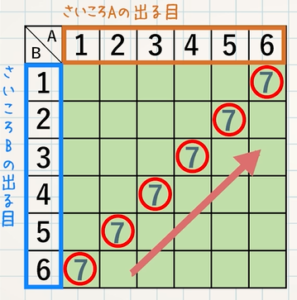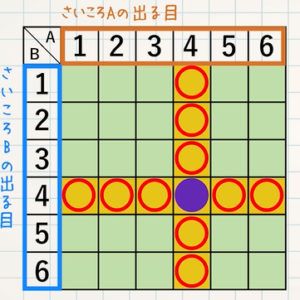\begin{eqnarray}\textcolor{blue}{確率({\rm P})=\frac{〇〇が起こる場合(a)}{起こるすべての場合(n)}}\end{eqnarray}
例えば、 $1$ つのさいころなら出る目は $1$~$6$ の $6$ 通りなので、分母が $6$ になります。
(1) $\textcolor{green}{2}$ の目が出る確率 $\textcolor{blue}{1}$ 通りなので、$\textcolor{red}{\frac{1}{6}}$
(2) $\textcolor{green}{5}$ 以上の目が出る確率は 「以上」は $5$ も含まれます。
$\textcolor{blue}{2}$ 通りなので、$\frac{2}{6}=\textcolor{red}{\frac{1}{3}}$
(3) 奇数の目が出る確率は
$1,3,5$ の $\textcolor{blue}{3}$ 通りなので、$\frac{3}{6}=\textcolor{red}{\frac{1}{3}}$
(4) $\textcolor{green}{7}$ 以上の目が出る確率 絶対に起こらない場合
$\textcolor{blue}{0}$ 通りなので、$\frac{0}{6}=\textcolor{red}{0}$
(5) $\textcolor{green}{1}$ 以上の目が出る確率 常に起こる場合
$\textcolor{blue}{6}$ 通りなので、$\frac{6}{6}=\textcolor{red}{1}$









